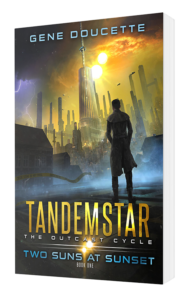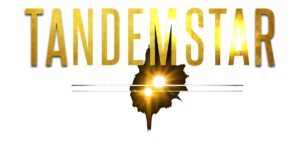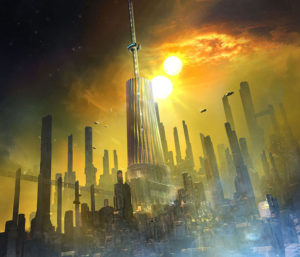Tandemstar: The Planet Dib
As we approach the release date for the first book in the Tandemstar series (Two Suns at Sunset, Book One in the Outcast Cycle) I thought it’d better carve out some time to discuss the planet itself.
Specifically, let’s talk about something that has always bothered me about created universes in works of fiction. Let’s call it the “What’s west of Westeros?” problem: fantasy and science fiction series set in different worlds almost never build out the entire planet.
One presumes the fantasy lands like in Martin’s A Song of Ice and Fire, or Tolkien’s Lord of the Rings are set on a planet, and that neither authors are flat-earthers. Despite that, both worlds have a here-there-be-dragons quality to their map edges. I know we’re supposed to accept that this part of the world is the world, but I’m the guy who’s always asking: when winter comes for Westeros, does it also come for every other continent on the planet? And do white-walkers cross the ocean, or is this purely a regional apocalyptic event?
In science fiction, most of the created worlds end up being stand-ins for individual countries: a monolithic political system with a leader who speaks for the entire planet. If aliens came to Earth today, who do you think they would speak to, and would that person actually be an appropriate representative for the whole planet’s interests?
And okay, I know why: anything else would make the story impossibly complex. Planets speak with one political voice because maybe the story isn’t about the planet at all, but about the people on the spaceship visiting the planet, so let’s not spend too much time getting into the weeds when we’re only there for a few chapters. And maybe we don’t need to tackle the concept of seasonal differences on a planet where winter itself is aperiodic and of an imprecise length. (What kind of axial tilt would such a planet even have?)
On the other hand, it seems like a missed opportunity.
The planet Dib
I think I’ve said this before, but one of my driving forces, as an author, is the question, “can I even pull this off?” Basically everything I’ve ever written began as a dare.
The immediate consequence of this kind of approach is that I’m hardly ever writing the same thing twice. You’ll find the most drastic display of this in Unfiction—which has at least six different genre styles in the same book—but it’s not hard to find elsewhere. All five of the novellas in The Immortal Chronicles are different kinds of stories: a pirate adventure, a hard-boiled detective story, a science fiction crossover, a Christmas tale, and a Regency romance. And with the Immortal novels, I strove to tell six different stories six different ways about the same character. To be completely honest one of the reasons I decided to wind down Adam’s adventures was because I can’t think of a seventh way.
The created universe of Tandemstar began with one big idea: If I create an entire world, with different continents and countries with different political systems, degrees of technological development, GDP and so on…I could tell as many stories as I wanted, in as many different ways as I wanted.
So that’s what I set out to do, starting last year. The planet Dib is now home to five continents (Geo, Unak, North and South Eloni, and Dorabon) a major island called Botzis and a large island chain called Canos-Holo, plus a bunch of smaller islands I’ll find time to work in later. It has a privately-owned orbiting space station called Lys, and over a dozen named countries (so far) with their own distinct political systems.
(Yes, a map is coming.)
About the stories
I’m also exploring different types of stories, in the same vein as described above, only now it’ll probably be a little easier. Unlike the first-person stories Adam the immortal man told, I have as many point-of-view characters at my disposal as I feel like, in as many different places as I choose. This naturally lends itself to a new storytelling voice—and therefore new genre-feel stories—all the time.
Book one is a detective story, and the voice is very much of the ‘hard-boiled’ variety. Here’s an excerpt:
The staircase leading to the apartment was external, and perilously steep, which was a common characteristic in this part of the city. The buildings in Kindontown looked to have been assembled haphazardly by a child god with a poor understanding of the basics of structural integrity. They leaned, and loomed, and most appeared top-heavy. (A lot of them were, thanks to probably-illegal apartments built out of plywood on top of roofs. Makk lived in one of them.) From the street level, it felt like the buildings were staring down from directly overhead, as if ripped from the nightmares of a worried agrarian on an unpleasant business trip.
In Makk’s version of this nightmare, the buildings were gaming tiles, stacked on their narrows and awaiting that child god to come along and tap the building at the end, sending them crashing down one by one.
In the same book, a second point of view character is living a more techno punk existence than the detective in the above excerpt:
Elicasta Sangristy did a quick skim of the feed data, looking for room to mash or trim. It wasn’t a full-on edit—there was no time, because she was up against true live. She wanted to hit the Stream on the same beat as the bulk live-dump Veesers, but with better-than-live content. That was the meat. That was how she got the subs.
The feed data was on a direct to her voicer screen, rather than the eyepatch optical. It was slightly less efficient, speed-wise, but it was what she was used to, and besides, it was better to proof the content on the same device her subs were most likely to use themselves. (Elicasta knew the stats; she had higher consumption in the handhelds than the ‘tops, at about 65-20, with the other 15 going to miscellaneous wearables.)
Finally, the point of view character in the second book in the series (still very much a work-in-progress) is waking up in a castle:
A soft wind bearing the scent of lilacs pushed aside the curtains in front of the open window, and in came the light from the twin rising suns. It was Sha-Sevvitch, the third month of the springtime season, and the whole valley was reveling in post-bloom glory.
Battine Alconnot, Lady Delphina, gave up on getting more sleep well before the sunlight made it all the way to her face.
The malevolence of birdsong, she thought, sliding out of bed and into a silk robe. The perpetual chill of a bedroom with stone walls was a shock, but the warm breeze from the window made up for it.
The second book takes place largely in the Middle Kingdoms, which is nine adjacent feudal countries at the juncture between North and South Eloni. The first book takes place in the city of Velon, in the country of Inimata, on the continent of Geo. The Middle Kingdoms eschew much of the technology embraced by Inimatans (for reasons that make sense in context) and the stories being told about the people in those places are of a different type.![]()
The third book will take place at least in part in a  totalitarian country called Wivvol, and will be the first that really delves into space exploration. Books four and five? Not sure yet, just like I’m not sure right now if there will need to be a book six needed to finish up The Outcast Cycle.
totalitarian country called Wivvol, and will be the first that really delves into space exploration. Books four and five? Not sure yet, just like I’m not sure right now if there will need to be a book six needed to finish up The Outcast Cycle.
Now if you’re asking, but what do these stories have to do with one another, other than being on the same planet? These are series books contributing to a larger story arc…it’s just that I can’t tell you what that is right now without spoiling it.
Trust me, it all makes sense in my head.
Join my mailing list, to receive my newsletter Writing from the border of Sorrow Falls. You can sign up from here.
